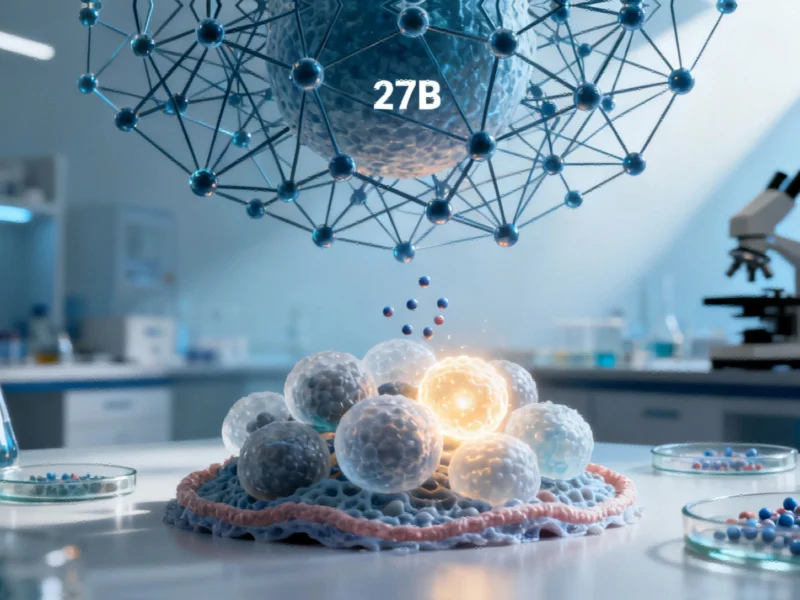In what could represent a watershed moment for artificial intelligence in healthcare, Google’s Gemma AI model has identified a previously unknown mechanism for making elusive cancer cells detectable to the immune system—a breakthrough that human researchers had pursued for decades without success. The announcement this week signals that AI may be transitioning from experimental tool to genuine scientific partner in solving humanity’s most persistent medical challenges.
The research collaboration between Google and Yale University leveraged a massive 27-billion-parameter foundation model specifically designed to understand human cellular biology. Unlike previous attempts with smaller models, this sophisticated AI system analyzed 4,000 different compounds and successfully predicted which drugs could function as “conditional amplifiers” to reveal hidden cancer cells. As detailed in recent coverage of Google’s AI cancer therapy breakthrough, the model identified both known compounds and unexpected candidates that could potentially transform cancer diagnosis and treatment.
The Cold Tumor Problem: AI’s Solution to a Medical Mystery
At the core of this discovery lies one of oncology’s most frustrating challenges: so-called “cold tumors” that evade detection by remaining invisible to the body’s immune system. These hidden cancers, common in advanced prostate and breast cancer cases, lack sufficient T-cell presence for diagnosis until the disease has progressed to later, more dangerous stages. The Google-Yale team tasked their AI with finding compounds that could boost antigen presentation—essentially making these invisible cancer cells visible to immune defenses.
“Where smaller models failed, the C2S-Scale 27B model succeeded spectacularly,” noted the research paper. The AI not only identified drugs with known capabilities in this area but also pinpointed “surprising hits”—compounds researchers hadn’t previously associated with this function. This demonstrates AI’s ability to identify non-obvious connections that might escape human researchers constrained by conventional thinking and existing literature.
Validation and Real-World Implications
The research team didn’t stop at computational predictions. They conducted laboratory validation using a combination of interferon and silmitasertib, one of the drugs identified by the AI model. The results confirmed the AI’s hypothesis: the treatment combination significantly increased antigen presentation and made previously “cold” tumors detectable. This critical validation step bridges the gap between theoretical AI discovery and practical medical application.
This breakthrough arrives amid broader corporate movements in AI strategy across multiple industries. The success of such large-scale models highlights why organizations are increasingly investing in specialized AI capabilities, even as they navigate the complexities of implementation.
Beyond Assistance: AI as Scientific Partner
What makes this development particularly significant is its demonstration of AI moving beyond its traditional roles as productivity tool or creative assistant. Unlike AI systems that help with diagnosis or administrative tasks, this model generated novel scientific hypotheses that advanced human understanding of cancer biology. The implications extend far beyond oncology, suggesting AI could accelerate discoveries across multiple scientific domains.
The timing coincides with major strategic acquisitions in the technology sector, where companies are positioning themselves to leverage AI capabilities across diverse applications. The biomedical field appears poised to become a primary beneficiary of these developments.
The Moonshot Moment for Medical AI
This achievement represents what many in the field have called AI’s “moonshot moment”—the point where theoretical potential transforms into tangible, life-changing applications. For years, proponents have argued that AI could help solve humanity’s most pressing problems, from disease to climate change, but concrete examples have been scarce. The Google-Yale collaboration provides compelling evidence that AI can indeed contribute to breakthroughs in areas where human researchers have reached impasses.
The breakthrough also aligns with broader patterns of AI-driven growth across multiple sectors, though the medical applications carry particularly profound implications for human health and longevity. As organizations worldwide grapple with security challenges in implementing advanced technologies, the medical research community appears to be establishing best practices for safe, effective AI integration.
Future Directions and Industry Impact
The success of Google’s biomedical AI model suggests we may be approaching an inflection point where AI transitions from assisting human researchers to collaborating with them as equal partners in discovery. This mirrors transformations happening elsewhere, including broader industry innovations where companies are leveraging AI to enter entirely new domains.
While questions remain about how quickly such discoveries can translate to clinical applications, the validation of the AI-generated hypothesis represents a crucial first step. The research demonstrates that properly trained large-scale models can identify biological mechanisms and therapeutic candidates that might otherwise remain undiscovered for years—potentially accelerating the pace of medical advancement and offering new hope for patients facing conditions that currently have limited treatment options.
The true significance may lie not in this single discovery, but in what it portends for AI’s future role in scientific research. If AI systems can reliably generate valid hypotheses in complex biological systems, we may be standing at the threshold of a new era of accelerated discovery across multiple scientific disciplines—with implications that could ultimately transform human health and longevity.
Based on reporting by {‘uri’: ‘techradar.com’, ‘dataType’: ‘news’, ‘title’: ‘TechRadar’, ‘description’: ”, ‘location’: {‘type’: ‘country’, ‘geoNamesId’: ‘2635167’, ‘label’: {‘eng’: ‘United Kingdom’}, ‘population’: 62348447, ‘lat’: 54.75844, ‘long’: -2.69531, ‘area’: 244820, ‘continent’: ‘Europe’}, ‘locationValidated’: False, ‘ranking’: {‘importanceRank’: 159709, ‘alexaGlobalRank’: 1056, ‘alexaCountryRank’: 619}}. This article aggregates information from publicly available sources. All trademarks and copyrights belong to their respective owners.



